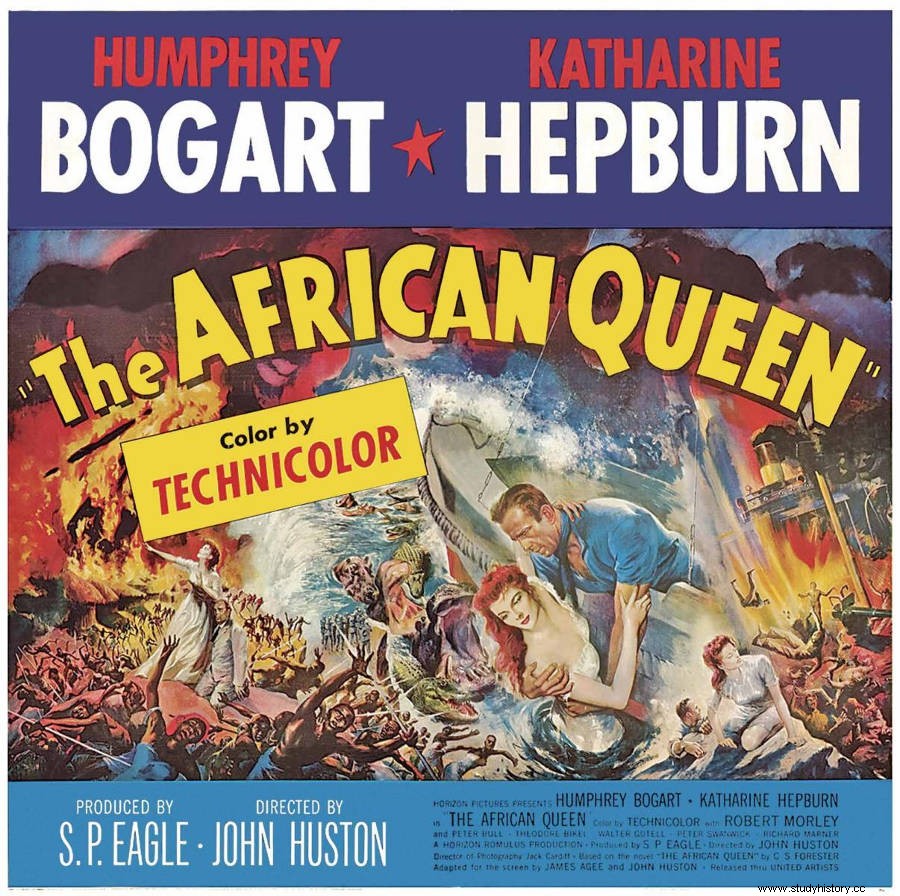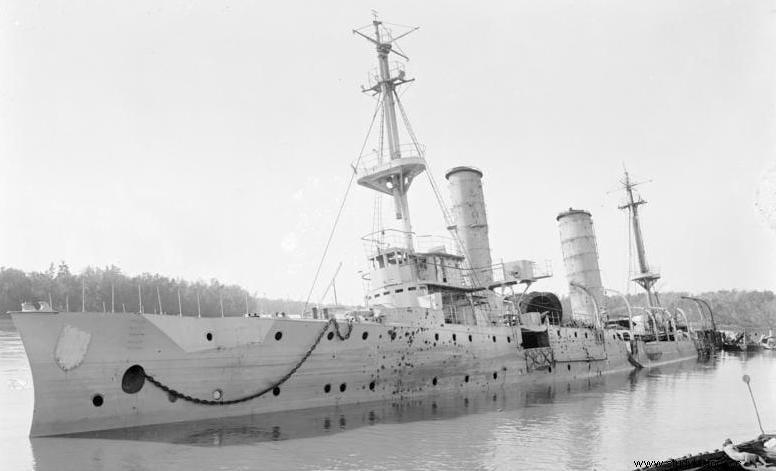Charlie Allnut, a drunken simpleton Canadian transporter who travels the Ulanga River aboard his boat, has to rescue Rose, the Puritan sister of a missionary killed by askaris Germans during World War I.
Together they flee by river aboard The African Queen going through a thousand adventures, in the course of which they become intimate and Rose convinces Charlie to avenge her brother by launching the boat, loaded with homemade torpedoes, against the German gunboat SS Königin Luise , owner of Lake Victoria.
I am not going to reveal more about John Huston's immortal film but I will focus on the plot, which is inspired by real events, although they occurred in another African lake, Tanganyika, in the battle that bears his name.

In fact, Huston, Humphrey Bogart and Katherine Hepburn, along with the rest of the crew, traveled to what is now Uganda for the shoot (Clint Eastwood recreated it in White Hunter, Black Heart ) and it is easy to recognize in several scenes the Murchinson Falls and the rapids that precede them, through which The queen of Africa falls. . In those years -the film was released in 1951- that was still the British Protectorate of Uganda, since it would not become independent until 1962.
However, the British and Germans fought hard to gain control of Lake Tanganyika, a huge and elongated body of water that, due to its dimensions (673 kilometers long by 72 wide and 32,900 square kilometers in area) and depth (the largest in the continent, with an average height of 570 meters but with maximum heights of 1,470 meters) served as a natural border between the Belgian Congo and Rhodesia on the one hand, and German East Africa, the colony that the Kaiser had owned since 1880, on the other. 
Although the most famous episodes of the conflict in those latitudes took place on land, with the campaigns of General Paul von Lettow-Vorbeck (who, despite always fighting in overwhelming inferiority, managed to make that front the only one in which Germany did not register any defeat ), the Tanganyika became a fundamental strategic objective and, thus, a series of naval confrontations took place between ships of both navies that probably half a century ago would have made the discoverers of the lake, the famous Richard Burton and John Hanning, rub their eyes Speke.
The Kaiserliche Marine had stationed two ships there:the Hedwig von Wissman (60 tons and armed with 4 cannons) and the Kingani (45 tons). The first entered combat in 1914, sinking the Belgian steamers Alexandre del Commune and Cecil Rhodes (the Congo also had a part of the lacustrine border), with which the Teutons remained absolute owners of the lake and even launched attacks -unsuccessful- on Rhodesia.

They were unopposed and only the Belgian navy had a large ship, the Baron Dhanis , weighing 1,500 tons, but had been transported in parts and had to be assembled in situ , which was impossible because the German ships would stop the work as soon as they discovered it.
In the spring of 1915 news reached the British Admiralty that the Germans were going to incorporate yet another ship, built in Papenburg and transported in parts to Dar es-Salaam, from where the same was done by rail to the Tanganyika. The Graf von Götzen , as it was called, was a monster 67 meters long and weighing 1,575 tons that could move nearly a thousand men from one point of the lake to another, which posed a serious danger. This had to be countered no matter what, and the opposite concept was chosen:carry several small gunships that could be mounted inadvertently.

The man chosen for the operation was Lieutenant Commander Geoffrey Spicer-Simpson, a rather unorthodox officer who was semi-retired having had a couple of accidents and lost a ship under his command; the truth is that there were not many more to choose from, as would also happen with the crews, completed with sailors from the reserve.
The boats that would leave for Africa were two 12-meter-long boats that were baptized as Mimí and Toutou . They armed themselves with a Maxim machine gun and a Hotchkiss cannon, and protected their gas tanks with extra armor.
After some bumpy tests on the Thames, the SS Llanstephen Castle transported them to Cape Town and then they were taken by train to Elizabethville, to follow a complex journey pulled by oxen, go up the Lualaba River by themselves (running aground more than once), cross Lake Kinsale, be loaded again by rail and finally arriving at Tanganyika in October, four months after the Graf von Götzen He sailed through her waters.

In fact, the Teutonic potential had been increased even more because the big guns of the cruiser SMS Königsberg , lost in the Rufiji river, were rescued and taken to the Kigoma base, while the rapid-fire ones settled in the Graf von Götzen , whose command was personally adopted by the German commander Gustav Zimmer, entrusting the Hedwig von Wissman Captain Jod Odebrecht and the Kingani Lieutenant Job Rosenthal. What the Belgians had opposed until then, under the command of Commander Stinghlamber, was almost useless:three outboard motor boats, not very well armed; the Baron Dhanis it was still dismembered.
Shortly before Christmas Mimí were thrown out and Toutou , who under the command of Lieutenant Junge began to search for the Kingani . Upon sighting it on December 26, 1915, they launched themselves in pursuit, having the advantage that its main cannon could only fire forward, so they could fire on it almost at will and in just eleven minutes they defeated it. The British took it away, fixed the damage, made some changes (the gun was moved to the stern and another of even larger caliber was placed in the bow) and renamed HMS Fifi . Suddenly they had one more unit in their fleet; two, to be exact, since the Alexandre Del Commune was rescued , it was repaired and the name changed to Vengeur .

After a waiting time due to heavy rains, the second act of the story arrived. Since there was no news of the Kingani , Zimmer sent Hedwig von Wissman in search of him... and instead of finding his mate he was suddenly attacked by him. It was the morning of February 8 and the German ship did find the Kingani , only, to her surprise, refurbished and in enemy hands, shooting at him alongside a furious swarm of one of the British gunboats plus two of the Belgian speedboats.
Odebrecht tried to withdraw seeking the protection of Graf von Götzen but he was unsuccessful and an agonizing battle ensued with the boats turning and firing around him as he returned fire as best he could or even tried to ram them. Finally, an accurate shot from HMS Fifi blew up Hedwig von Wissman's boiler , causing a fire on board her. The ship sank when Odebrecht exploded charges to prevent it from also falling into the hands of the adversary. Of course, the flag was captured along with twenty prisoners.
It was time for the third act and it was the next day, when the Graf von Götzen also appeared in search of his companions. But this was a much harder nut to crack, and Spicer-Simpson erred on the side of caution. Instead of attacking him, he went to Stanleyville (present-day Kisangani) to get a ship that, duly reformed, could face the German. The chosen one was one named St. George , owned by the British consul and had a steel helmet. The St. George she was butchered and transferred in May to Tanganyika, where, meanwhile, the picture had changed quite a bit.

Indeed, Kigoma was about to fall into Allied hands and an operation was under way against Bismarckburg (present-day Kasanga) supported by the flotilla from the lake. The Germans managed to evacuate the city in dhows (traditional sailing ships) by tricking the British by using wooden dummies placed on the parapets. Spicer-Simpson got a good rant, destroying the prestige he had earned those previous months. But in a state of war, events unfold rapidly and soon a new and long-awaited target was set:the Graf von Götzen .
Attempts were first made to sink it by aerial bombing with four Short Type 827 biplane seaplanes flown by Belgian pilots. Things did not bode well for the ship, so Zimmer ordered it dismantled and handed over the cannons to Von Lettow.
The works were carried out without problems because, as in Bismarckburg, the disassembled pieces were replaced by others made of painted wood, giving the impression that the Graf von Götzen it was fully operational. When Kigoma fell on July 28, 1916, the ship was scuttled by her own crew. 
In this way, the Battle of Lake Tanganyika ended with an allied victory and British-Belgian control of the area. Spicer-Simpson received the Distinguished Service Medal but was never awarded a command again because of her ongoing problems with the Belgians (who, paradoxically, also awarded her the Croix de Guerre and made him a member of the Ordre de la Couronne ).
One last curiosity:the Graf von Götzen she would be raised in 1921 by the Belgian colonial government, she would sink in a subsequent storm, and would be brought to the surface again in 1924, this time by the British. Following some repairs, she re-entered service as a shuttle three years later; she unbelievably, she still cruises Lake Tanganyika, now under the name MV Liemba .
